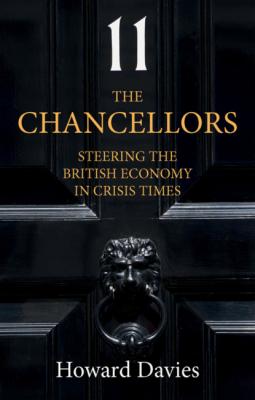ТОП просматриваемых книг сайта:
The Chancellors. Howard Davies
Читать онлайн.Название The Chancellors
Год выпуска 0
isbn 9781509549559
Автор произведения Howard Davies
Издательство John Wiley & Sons Limited
In the next chapter I will review the conduct of fiscal policy during the period, but there is an alternative critique of the macroeconomic policy framework which has become more prominent since the financial crisis, and particularly in the Covid pandemic.
That critique maintains that the primacy of the inflation target has already led to suboptimal economic performance, and could seriously hinder further recovery. Simon Wren-Lewis of Oxford University, for example, has argued that ‘to continue with inflation as the primary target could jeopardise a macroeconomic policy that focuses on strong growth, and quickly offsets any negative shocks’.19 He notes that the Fed’s dual mandate allows it to prioritize maximum unemployment and look through temporary increases in inflation. Indeed, the Fed has recently reviewed its approach to the target and declared that in future it will adopt an ‘averaging’ methodology, which allows it to tolerate overshoots to ‘catch up’ with past shortfalls.
Presenting the new policy, Jerome Powell, chair of the Fed since 2018, noted that, in an environment where inflation expectations are very low, interest rates ‘decline in tandem’. As a result, ‘we would have less scope to cut interest rates to boost unemployment during an economic downturn, further diminishing our capacity to stabilize the economy through cutting interest rates. We have seen this adverse dynamic play out in other major economies.’ To prevent such a dynamic establishing itself in the US, the Fed decided that in future ‘employment can run at or above real-time estimates of its maximum level without causing concern’ and ‘following periods when inflation has been running below 2 percent, appropriate monetary policy will likely aim to achieve inflation moderately above 2 percent for some time’.20
The Bank of England argues that the UK inflation target regime, with its focus on inflation at a two-year time horizon, allows it the flexibility to look through temporary overshoots, as it did in 2010. It argues furthermore that since 2010 there has been no undershoot of the target, as there has been in the US and the Eurozone. But, as Wren-Lewis points out, interest rates have been at or close to their lower bound for some time, and the policy tool then available, QE, ‘is just too unreliable compared to interest rates or fiscal policy’.
Ed Balls and colleagues at Harvard Business School have argued that in these circumstances a closer nexus between monetary and fiscal policies is required. They recommend that the Governor should be mandated to write to the Chancellor suggesting the scale of fiscal stimulus they think is needed when interest rates are at their lower bound.21 Support for that approach came from Olivier Blanchard, the former Chief Economist of the IMF, who argues that if interest rates remain lower than the growth rate, and if monetary policy is constrained by the zero lower bound, it makes sense to run fiscal deficits to sustain demand, even if this leads to a further increase in debt.22
So far, neither the Bank of England itself nor the Treasury has shown any signs of being interested in amending the policy framework in this way. If the post-Covid recovery is again sluggish, as the post-GFC recovery was, the question of monetary and fiscal policy coordination will rise up the agenda, but the Bank of England will certainly resist any change which puts its monetary policy independence at risk.
Notes
1 1. Interview with the author, August 2021.
2 2. ECB’s governing council approves its new monetary policy strategy. 8 July 2021. https://publications.banque-france.fr/sites/default/files/medias/documents/2021-07-08_-_ecbs_governing_council_approves_its_new_monetary_policy_strategy.pdf.
3 3. Quoted in Camilla Hodgson, Bank of England given new mandate to buy ‘green’ bonds. Financial Times, 3 March 2021. https://www.ft.com/content/f436d69b-2bf0-48cd-bb34-644856fba17f.
4 4. John Cochrane, Central banks and climate: A case of mission creep. Hoover Institution, 13 November 2020. https://www.hoover.org/research/central-banks-and-climate-case-mission-creep.
5 5. Mervyn King and Dan Katz, Central banks are risking their independence. Bloomberg Opinion. 23 August 2021. https://www.bloomberg.com/opinion/articles/2021-08-23/central-banks-are-risking-their-independence-mervyn-king-dan-katz.
6 6. Interview with the author, March 2021.
7 7. Daniel Harari and Matthew Ward, Quantitative easing. House of Commons Library. CDP 2016/0166, 14 September 2016. https://researchbriefings.files.parliament.uk/documents/CDP-2016-0166/CDP-2016-0166.pdf.
8 8. Quoted in James Dorn, Maintaining distance between monetary and fiscal policy. Cato Institute, 18 November 2020. https://www.cato.org/publications/pandemics-policy/maintaining-distance-between-monetary-fiscal-policy#.
9 9. HM Treasury and the Bank of England announce temporary extension of Ways and Means facility. 9 April 2020. https://www.bankofengland.co.uk/news/2020/april/hmt-and-boe-announce-temporary-extension-to-ways-and-means-facility.
10 10. Chris Papadopoullos, The Bank of England nearly financed the deficit. Does it matter? OMFIF, 21 January 2020. https://www.omfif.org/2021/01/the-bank-of-england-nearly-financed-the-deficit-does-it-matter/.
11 11. Andrew Bailey, Bank of England is not doing ‘monetary financing’. Financial Times, 5 April 2020. https://www.ft.com/content/3a33c7fe-75a6-11ea-95fe-fcd274e920ca.
12 12. Tommy Stubbington and Chris Giles, Investors sceptical over Bank of England’s QE programme. Financial Times, 5 January 2021. https://www.ft.com/content/f92b6c67-15ef-460f-8655-e458f2fe2487.
13 13. Andy Haldane, What has central bank independence ever done for us? UCL Economists’ Society Economics Conference, 28 November 2020. https://www.bankofengland.co.uk/-/media/boe/files/speech/2020/what-has-central-bank-independence-ever-done-for-us-speech-by-andy-haldane.pdf?la=en&hash=E89B59B9A236C37F6DCE94CDC567B38A52835813.
14 14. Charles Goodhart and Manoj Pradhan, Future imperfect after Coronavirus. VoxEU, 27 March 2020. https://voxeu.org/article/future-imperfect-after-coronavirus.
15 15. Inflation: A tiger by the tail? Speech by Andy Haldane, 26 February 2021. Скачать книгу

